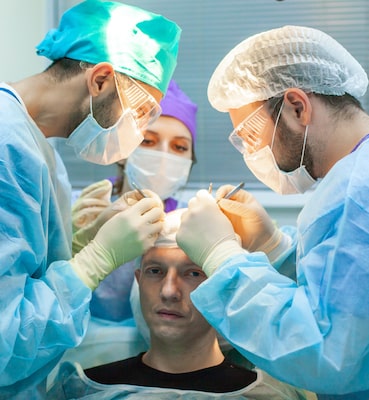A hair transplant is an ideal hair restoration procedure for patients who are experiencing hair loss on the scalp. The hair loss can be visible to others in the form of bald spots on the scalp or it can take the form of thinning hair. Hair loss does not have to be a permanent condition as hair transplants are able to restore the hairline and give the impacted areas of the scalp a full and dense appearance.
Curious about what is involved in undergoing a hair transplant? Let’s look at how it is performed as well as the most popular hair transplant method.
Hair Transplant Consultation Appointment
The first step in the hair restoration process is scheduling a consultation appointment with a board-certified and experienced hair transplant surgeon. The doctor will examine the scalp of the patient in order to determine the extent of the hair loss as well as the cause of the condition. The doctor will also examine the medical history of the person to make sure the patient is healthy enough to have a hair transplant.
The doctor will also discuss the type of results the patient hopes to see once the surgery and the recovery process are completed. The surgeon will set realistic expectations so the person will know what type of results they can expect after the surgery. It is important to set realistic expectations so the patient will not be surprised or disappointed by their new look.
FUE Explained
 Follicular Unit Extraction (FUE) hair transplant involves hair grafts being transplanted on an individual basis to the targeted area of the scalp. The hair grafts are normally taken from the “donor area” of the scalp and this area is located on the back and sides of the scalp. The hair located in these areas have been shown to be resistant to balding which is why hair transplant surgeons like to use the hair from the donor area.
Follicular Unit Extraction (FUE) hair transplant involves hair grafts being transplanted on an individual basis to the targeted area of the scalp. The hair grafts are normally taken from the “donor area” of the scalp and this area is located on the back and sides of the scalp. The hair located in these areas have been shown to be resistant to balding which is why hair transplant surgeons like to use the hair from the donor area.
If there is not enough high-quality hair located in the “donor area,” the necessary hair grafts can come from other areas on the body such as the beard and the chest. The number of hair grafts that are needed depends on the amount of hair loss on the scalp. In addition, the number of necessary hair grafts is also determined by the final results desired by the patient. A larger number of hair grafts might be needed to provide the planned hair restoration results to the hairline. However, hair transplant surgeons will not transplant an excess number of hair grafts that make the results look unrealistic in appearance.
As mentioned earlier, the hair grafts are transplanted individually into the balding area of the scalp. Unlike older hair transplant methods such as Follicular Unit Transplantation (FUT) that leave a scar since the hair grafts are surgically removed in a strip of skin from the scalp, the individual removal of the hair grafts means there is no visible scarring in the donor area of the scalp. The transplanted hair grafts will settle into their new location and begin to grow like the native hair that is already located in the targeted area.
While the final results of a Follicular Unit Extraction procedure are permanent, this does not mean that additional balding or thinning of the hair cannot occur as a person continues to age. The additional loss of hair will not occur where the hair grafts were transplanted. It can happen on other areas of the scalp which means future hair restoration procedures might be necessary to address new areas of hair loss in the future.
FUE – Final Results
The final results of FUE hair transplant do not happen overnight. While the amount of recovery time varies for each patient, the results are generally seen anywhere from 12-18 months after the surgery.
The transplanted hair grafts will grow naturally once they are placed in the scalp so the new hair will not suddenly appear and make it obvious to others that a surgical procedure was performed to restore the hair. Instead, the hair will grow at a normal pace so it will not be obvious to others that a hair transplant was performed.
Hair Transplant Surgery – Next Steps
A person who is interested in having a hair transplant needs to perform proper research to learn more about the procedure and how it is performed. A well-informed patient is one that is prepared to make a decision about having the procedure.
Once the consultation appointment is made, the patient should make a list of questions they want to ask the surgeon. The consultation appointment is a good “one on one” opportunity to ask questions and share any concerns about the process. A surgeon who is not willing to answer questions or does not give clear answers that are easy to understand is likely not the right choice to perform the surgery. It is important for a patient to feel comfortable interacting with the doctor.
Once the patient has the necessary information about the complete hair transplant process, a final decision can be made about having a hair transplant.